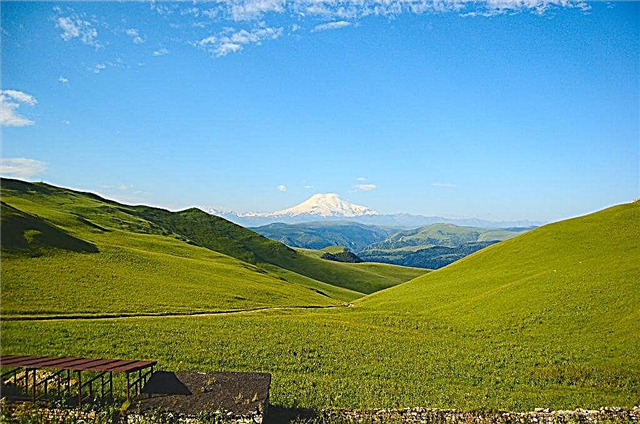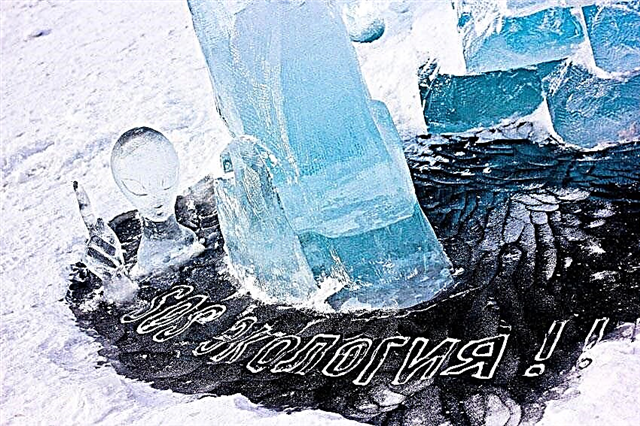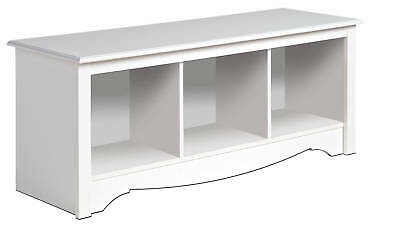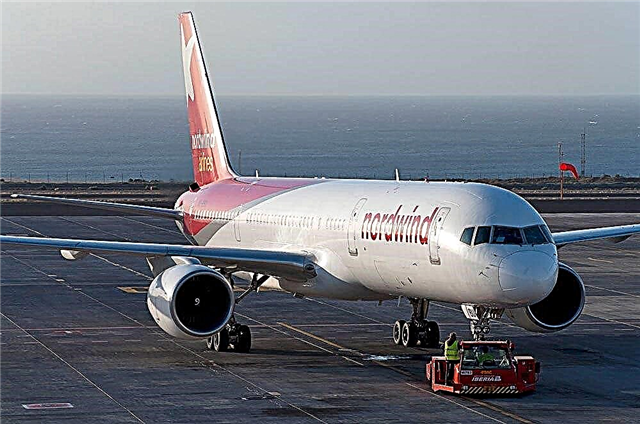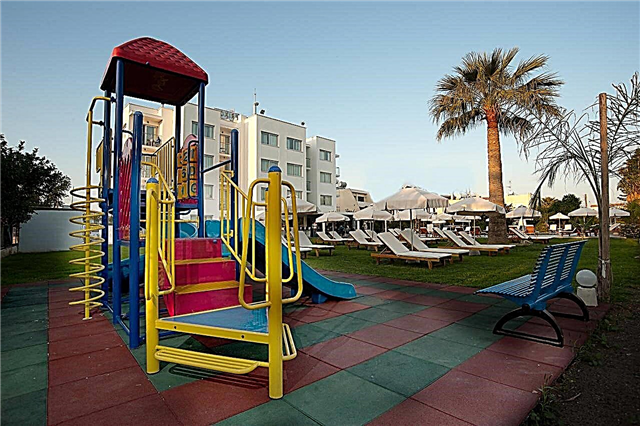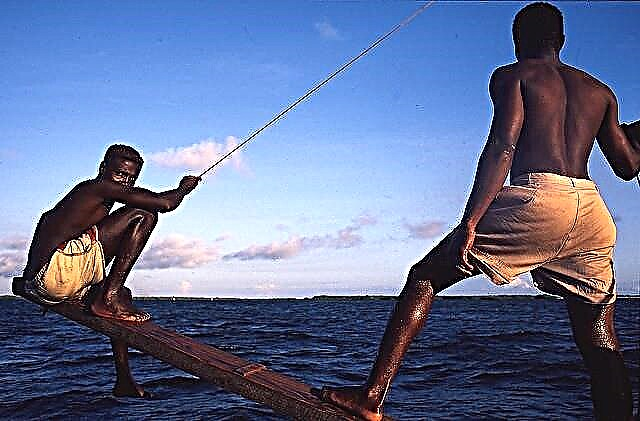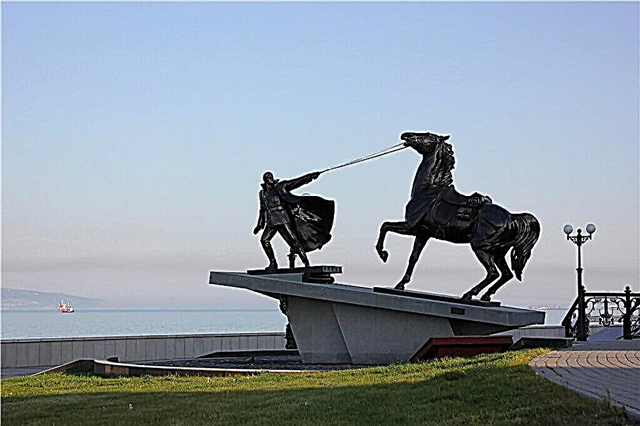Novorossiysk belongs to the Krasnodar Territory and is located on the coast of the Tsemesskaya Bay. To start your acquaintance with the monuments of the city, it is best to go to the embankment named after Admiral Serebryakov. There are both military monuments, such as a monument to an unknown sailor, and "civilian" ones, for example, "Girl on a ball".
Many monuments of Novorossiysk are dedicated to the events of 1943. Then in the city and the surrounding area there were fierce battles for the liberation of the city from the Nazis. Everyone contributed: sailors, partisans, pilots. Hence, there are so many memorials and sculptural compositions: you need to try to celebrate different heroes. One of the most notable monuments of this cycle is called "Small Land" and shows the moment when soldiers disembark on the shore.
Historical and modern monuments of Novorossiysk
List of the most famous monuments in the city.
"Sea Glory of Russia"
The column was erected in 2007 on the embankment named after Admiral Serebryakov. At its top is an angel holding a model of a sea brig with three masts above his head. The height of the monument is over 11 meters, the diameter of the column is 1.5 meters. The author of the project is the artist Alexander Apollonov. The design was created taking into account the local climate, so that the column is able to withstand strong gusty winds.

Monument to the founding fathers of Novorossiysk
The opening took place in 2007. The monument was created by Alexander Suvorov. The sculptural group depicts Lazar Serebryakov, Nikolai Raevsky and Mikhail Lazarev. They are considered the founders of Novorossiysk. The military landed on the local coast in 1838 and almost immediately took up the construction of fortifications erected on the basis of the destroyed Turkish fortress. The modern city grew out of their camp.

"Fire of Eternal Glory"
The architectural ensemble of the square was created in the 50s, the fire was lit in 1958 and is dedicated to the fallen soldiers who defended the city during the Great Patriotic War and especially in 1943. Located in the Alley of Heroes. Nearby there is a memorial wall and a mass grave. For the first time, they lit the Eternal Flame from a torch brought by the cruiser "Mikhail Kutuzov" from Sevastopol. One of Shostakovich's musical compositions is playing near the memorial. There were almost always fresh flowers here.

"Small earth"
The memorial was created on the site where Soviet troops in 1943 fought for the city against the Nazis. In many ways, these events predetermined the outcome of the battle for the Caucasus. The opening took place in 1982. The monument is associated with the bow of a ship crashing into the shore at full speed. On the one hand, the bas-reliefs depict scenes of war, on the other, a sculptural group - soldiers landing on land.

"Torpedo boat"
In the past, the TK-718 was a real combat ship. Ships of this type played an important role in the liberation of the city from the Nazis in 1943. This particular boat "fought" on the Black Sea throughout the Great Patriotic War. It was written off after the expiration of its service life. In 1968, the boat was turned into a monument and installed on the embankment. Its pedestal resembles a wave, which makes the composition more atmospheric.

Monument to the Unknown Sailor
It was created in 1961 and since then has never left the city embankment. The very figure of a sailor is cast in bronze. The authors gave their hero a serious and decisive look. He looks into the distance and as if froze for a second before taking a step forward. The pedestal is made of stone. The total height of the monument is 7 meters. Although the image is collective, the sailor had a real prototype - midshipman Kovylnikov.

Hamsa monument
There are no other sculptural dedications to this fish species in the world. During the war years, when food was very bad, it was the hamsa catching that saved the residents of Novorossiysk from starvation. Alexander Suvorov finished work on the monument back in 2011. However, permission to install it had to wait until 2017. The pedestal is made in the form of a wave, and there is a jamb of anchovy on it. You can find a monument in the area of the fish factory.

Monument to Geshe Kozodoev
One of the most unusual monuments of the city is located right in the water in Tsemesskaya Bay. It illustrates a shot from the film "The Diamond Arm" with the participation of the character of Andrei Mironov. The bronze sculpture of Gesha Kozodoev was installed on a miniature bulk island in 2010. The appearance of the monument in Novorossiysk gave rise to a legend that the comedy Gaidai was filmed here, but this is not true.

"To the sailors of the revolution"
The monument was erected in 1980 in the Tsemesskaya Bay. The monument is dedicated primarily to the events of 1918. Then the sailors were forced to sink the ships, since they could not take full advantage of them and did not want to give them up to the enemy. The height of the kneeling sailor is 12 meters. In one hand, he holds a peakless cap, and presses the other to his heart. Due to its size, the monument is clearly visible from land and sea.

"Line-line of defense"
The memorial comes close to the walls of a cement plant on the eastern bank of the Tsemesskaya Bay. The reinforced concrete structure is suspended above the road. On one side of the wall are the awards received by the city during its existence. On the other hand, four hands protrude, gripping the weapon. And on a support made of granite, the names of the units and formations that defended Novorossiysk from the Nazis are listed.

"Exodus"
The composition appeared on the coast in 2013. It is dedicated to the revolutionary events when the White Guards were forced to leave the country, now controlled by the "red". The height of the monument together with the pedestal is about 7 meters. It depicts an officer and his horse. The horse rests and does not want to climb aboard the soon sailing ship. The author of the project is sculptor Alexander Suvorov.

To the dead fishermen of the seiner "Urup"
The monument is dedicated to the tragic events of 1953. Then the hurricane caused the death of 12 fishermen who worked in the fishing collective farm "Chernomorets". The company paid for the creation of a monument in their honor. The project was completed in 1959. At the same time, the opening ceremony was held on the embankment named after Admiral Serebryakov. The monument has the status of a federal art object.

"Dolphins on the Wave"
The sculptural composition has been located on the embankment named after Admiral Serebryakov since 2008. It was installed as close to the water as possible. The pedestal is made in the form of a wave, and four dolphins of different sizes are placed on it. The monument is completely made of bronze. It turned out to be positive and supportive, so in good weather there are always people nearby who want to take a photo.

"Girl on a Dolphin"
Another monument to the embankment named after Admiral Serebryakov. People often call him "Dolphin and Mermaid". Although formally this name is incorrect: the girl has no tail. The height of the sculptural composition is approximately 2.6 meters. The dolphin itself is placed on a small stone pedestal, and a girl sits on its back. The material of the monument is metal, but it looks like bronze, as it is painted in the appropriate color.

"To the sailor's wife"
Alexander Suvorov in 2010 created a project that has long been nurtured by the city authorities. This is how a sculpture of a woman with a child in her arms appeared on the embankment, waving after an invisible ship. The height of the monument is 2.3 meters. The composition has several unofficial names, including the popular “Sailor”. Some residents would like to move the monument so that the "sailor's wife" looks towards the open sea.

Monument to M.P. Lazarev
Located on the embankment opposite the "Cruiser Mikhail Kutuzov". Installation date - 1996. The sculptor is Alexander Suvorov. The bust is made of bronze, but covered with black paint to avoid metal oxidation and rapid wear. Mikhail Lazarev is a navigator, admiral and one of the founders of the city.In his asset, among other feats, three travels around the world and successful military operations against the Turks.

"Girl on the Ball"
Located at the beginning of the Admiral Serebryakov embankment. Alexander Komm used the famous painting of the same name by Pablo Picasso as a basis. The Novorossiysk "Girl on the Ball" is made of cast iron and stands on a marble base. The disputes of tourists about the sex of the child do not stop, many are sure that this is a boy. The project was created in 2006. A public garden was specially laid out for it.

"Novorossiysk who died in undeclared wars"
The monument has been located in the Frunze Park since 1999. Alexander Suvorov was in charge of the project. Initially, the composition consisted only of angels holding a shield with the names of 27 dead heroes of undeclared wars and military conflicts. But later a rectangular obelisk was added, faced with granite slabs. New memorial plaques have been installed on it, as the number of those killed has increased.

"To the soldiers-defenders of the city of Novorossiysk 1942-1943"
The monument was opened in 1961 on Freedom Square. The composition was installed on a diorite pedestal. Figures included in the sculptural group: a sailor with a machine gun in his hand, a partisan girl with a rifle over her shoulders and an infantryman holding a banner. In 1942-1943, different types of troops united to protect the city from the Nazis. The total height of the monument is about 18 meters. The pedestal is separately decorated with bas-reliefs depicting scenes of the war.

Monument to V.I.Lenin
It was donated to Novorossiysk by residents of St. Petersburg in 1926. The height of Lenin's figure is 1.75 meters. There is a bronze Vladimir Ilyich on a granite pedestal, to which there are steps. The leader of the world proletariat is depicted at the time of the speech. His hand is raised and his mouth is open. At the base of the pedestal there is a sculptural group that does not fit into the ensemble very stylistically.

"Novorossiysk republic"
The project was dedicated to the events of the first Russian revolution and a monument was erected in 2008. The laying of the stone, indicating that a corresponding monument will appear here, took place 33 years earlier. The chief sculptor is Alexander Suvorov. In 1905, workers 'and peasants' self-government was established in Novorossiysk. It lasted less than 2 weeks in December, but left a mark on history.

Monument to A.S. Pushkin
The installation was timed to coincide with the 200th anniversary of the poet in 1999. Although many monuments to Pushkin have been created in Russia, this one is considered one of the most interesting. The poet sits on a wide bench with a notebook in one hand and a quill in the other. He is agitated and thoughtful at the same time: the authors of the monument captured the Cannons at the time of work on the next work. There is a fountain in front of the bronze monument.

Monument to V.K.Kokkinaki
The bust was installed in 1975. Vladimir Kokkinaki is an honorary resident of Novorossiysk, a front-line soldier, twice Hero of the USSR. He made his greatest contribution to history as a test pilot. Since the aircraft of that time were far from perfect, changes often had to be made during operation, and experienced pilots were worth their weight in gold. It was thanks to Kokkinaki, for example, that the IL-2 began to be mass-produced.

"Stranger in the carriage"
The monument has many similarities with the painting by Ivan Kramskov. Installation took place in 2006. Both the girl and the carriage are made in full size. The materials used are mainly bronze and cast iron. The absence of a coachman only adds to the tourists' desire to make an unusual photo session: you can take both a seat on the irradiation room and in the carriage. Access to the composition is free at any time of the year.

Monument to E. Ya. Savitsky
Evgeny Savitsky - front-line soldier, twice Hero of the USSR. In his small homeland, a bust was installed in 1950. The pilot was portrayed in military uniform with orders and medals on his chest, as if he had only distracted from his helm for a second. The text of the decree on awarding the lieutenant general with the second gold star is written on the pedestal. From the place where the bust is installed, to the Pushkin monument is about 200 meters.

Monument to L. Brezhnev
The official name is "The Man Walking Through the City." The only monument to Leonid Ilyich in Russia was erected in 2004. The sculptor Nikolai Bugaev portrayed the General Secretary as full of strength and energy. The height of the monument is more than 4 m. Brezhnev not only lived in Novorossiysk, but defended the city. In 2010, the monument was moved to rebuild the park and make a boulevard. Now the face of the monument is turned to the sea.

Monument-plane Il-2
Installed near the yacht club, there is also the Museum of Military Glory nearby. The IL-2 model entered mass production in 1939. About 36 thousand of such aircraft were produced, but this particular one has an interesting history. He took part in battles during the Great Patriotic War and was shot down. IL-2 lay on the seabed until 1974. And then it was raised, restored and made a monument in 1980.

"The front line of the defense of Malaya Zemlya"
Another name is "Sailor with a grenade". The monument, like many military monuments of the city, is dedicated to the events of 1943. In this place was the line of defense, which was defended by hook or by crook. The sailor steps out of the snow-white wall and is about to throw a grenade. A map is drawn on the back, and several more marks are made that are understandable to people who know the history of the city. The monument was opened in 1972.

"Valley of Death"
The memorial complex is located in Myskhako. Here, on Malaya Zemlya, in 1943 bloody battles for the city took place. The composition was created by a group of local sculptors. They completed work in 1974. At the entrance to the territory there is a stele with information about the events of the Great Patriotic War. The complex includes the monuments "Well of Life", "Front End", "Explosion". The plane tree planted by Brezhnev also grows here.

Monument to the partisans of the Novorossiysk bush
In 1947, partisans who had died back in 1943 were buried in the Lenin Park. A year after the ceremony, a monument was erected to commemorate their feat. A small stele is faced with granite slabs. Mourning inscriptions are made on them, briefly telling the history of the monument. The partisan movement in the region was numerous and helped the regular troops to turn the tide of events at the front.


